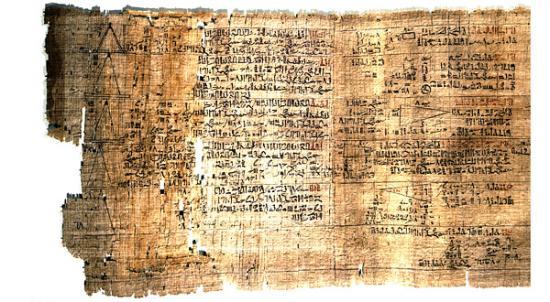Math puzzles’ oldest ancestors took form on Egyptian papyrus
Pam Belluck
Source : http://www.nytimes.com/2010/12/07/science/07first.html?_r=1&src=dayp
 British Museum
British Museum
CALCULATIONS. The scribe of the Rhind Mathematical Papyrus, an Egyptian document more than 3,600 years old, introduces the roughly 85 problems by saying that he is presenting the “correct method of reckoning, for grasping the meaning of things and knowing everything that is, obscurities and all secrets.”
“As I was going to St. Ives
I met a man with seven wives. ...”
You may know this singsong quiz,
But what you might not know is this:
That it began with ancient Egypt’s
Early math-filled manuscripts.
It’s true. That very British-sounding St. Ives conundrum (the one where the seven wives each have seven sacks containing seven cats who each have seven kits, and you have to figure out how many are going to St. Ives) has a decidedly archaic antecedent.
An Egyptian document more than 3,600 years old, the Rhind Mathematical Papyrus, contains a puzzle of sevens that bears an uncanny likeness to the St. Ives riddle. It has mice and barley, not wives and sacks, but the gist is similar. Seven houses have seven cats that each eat seven mice that each eat seven grains of barley. Each barley grain would have produced seven hekat of grain. (A hekat was a unit of volume, roughly 1.3 gallons.)
The goal: to determine how many things are described. The answer: 19,607.
The Rhind papyrus, which dates to 1650 B.C., is one of several precocious papyri and other artifacts displaying Egyptian mathematical ingenuity. There is the Moscow Mathematical Papyrus (held at the Pushkin State Museum of Fine Arts in Moscow), the Egyptian Mathematical Leather Roll (which along with the Rhind papyrus is housed at the British Museum) and the Akhmim Wooden Tablets (at the Museum of Egyptian Antiquities in Cairo).
They include methods of measuring a ship’s mast and rudder, calculating the volume of cylinders and truncated pyramids, dividing grain quantities into fractions and verifying how much bread to exchange for beer. They even compute a circle’s area using an early approximation of pi. (They use 256/81, about 3.16, instead of pi’s value of 3.14159....)
It all goes to show that making puzzles is “the most ancient of all instincts,” said Marcel Danesi, a puzzle expert and anthropology professor at the University of Toronto, who calls documents like the Rhind papyrus “the first puzzle books in history.”
Dr. Danesi says people of all eras and cultures gravitate toward puzzles because puzzles have solutions.
“Other philosophical puzzles of life do not,” he continued. “When you do get it you go, ‘Aha, there it is, damn it,’ and it gives you some relief.”
But the Egyptian puzzles were not just recreational diversions seeking the comforting illusion of competence. They were serious about their mission. In the Rhind papyrus, its scribe, known as Ahmes, introduces the roughly 85 problems by saying that he is presenting the “correct method of reckoning, for grasping the meaning of things and knowing everything that is, obscurities and all secrets.”
And the documents were practical guides to navigating a maturing civilization and an expanding economy.
“Egypt was going from a centralized, structured world to partially being decentralized,” said Milo Gardner, an amateur decoder of Egyptian mathematical texts who has written extensively about them. “They had an economic system that was run by absentee landowners and paid people in units of grain, and in order to make it fair had to have exact weights and measures. They were trying to figure out a way to evenly divide the hekat so they could use it as a unit of currency.”
So the Akhmim tablets, nearly 4,000 years old, contain lists of servants’ names, along with a series of computations concerning how a hekat of grain can be divided by 3, 7, 10, 11 and 13.
The Egyptian Mathematical Leather Roll, also from about 1650 B.C., is generally considered a kind of practice test for students to learn how to convert fractions into sums of other fractions.
The Rhind papyrus contains geometry problems that compute the slopes of pyramids and the volume of various-shaped granaries. And the Moscow papyrus, from about 1850 B.C., has about 25 problems, including ways to measure ships’ parts and find the surface area of a hemisphere and the area of triangles. Especially interesting are problems that calculate how efficient a laborer was by how many logs he carried or how many sandals he could make and decorate. Or the problems that involve a pefsu, a unit measuring the strength or weakness of beer or bread based on how much grain is used to make it.
One problem calculates whether it’s right to exchange 100 loaves of 20-pefsu bread for 10 jugs of 4-pefsu malt-date beer. After a series of steps, the papyrus proclaims, according to one translation: “Behold! The beer quantity is found to be correct.”
The problems in these ancient texts are not difficult by modern mathematical standards. The challenge for scholars has come in deciphering what the problems are saying and checking their accuracy. Some of the numerical equivalents are written in a symbolic system called the Eye of Horus, based on a drawing representing the eye of the sky god Horus, depicted as a falcon. Sections of the falcon’s eye are used to represent fractions: one-half, one-quarter and so on, up to one sixty-fourth.
Scholars have found a few errors in the problems, and Ahmes even wrote an incorrect number in his St. Ives problem. But over all, the equations are considered remarkably accurate.
“The practical answers are solved,” Mr. Gardner said. “What is unsolved about them is the actual thinking in the scribe’s head. We don’t know exactly how he thought of it.”